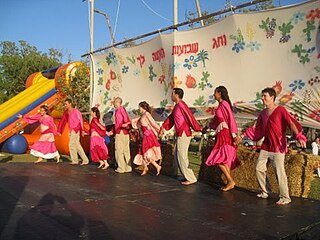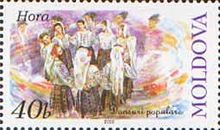
Circle dance, or chain dance, is a style of social dance done in a circle, semicircle or a curved line to musical accompaniment, such as rhythm instruments and singing, and is a type of dance where anyone can join in without the need of partners. Unlike line dancing, circle dancers are in physical contact with each other; the connection is made by hand-to-hand, finger-to-finger or hands-on-shoulders, where they follow the leader around the dance floor. Ranging from gentle to energetic, the dance can be an uplifting group experience or part of a meditation.
Antikristos or Antikrystós is a dance of Greek origin. “Aντικρυστός” in Greek language refers to the verb αντικρύζω “be across, opposite, face-to-face”. It is also known in Armenia. Antikristos has similarities with the karsilamas dance. It is danced in couples.
Choreia is a circle dance accompanied by singing, in ancient Greece. Homer refers to this dance in his epic poem, the Iliad.

Čoček is a musical genre and dance that emerged in the Balkans during the early 19th century. It features prominently in the repertoire of many Romani brass bands.

Kolo is a South Slavic circle dance, found under this name in Bosnia and Herzegovina, Croatia, Slovenia, and Serbia. It is inscribed on the UNESCO List of Intagible Cultural Heritage for Serbia.
The music of Thrace, a region in Southeastern Europe spread over southern Bulgaria, northeastern Greece, and European Turkey, contains a written history that extends back to the antiquity, when Orpheus became a legendary musician and lived close to Olympus. Though the Thracian people were eventually assimilated by surrounding Balkan groups, elements of Thracian folk music continue.

Israeli folk dance is a form of dance usually performed to songs in Hebrew, or to other songs which have been popular in Israel, with dances choreographed for specific songs. Israeli dances include circle, partner and line dances. As almost all dances are intentionally choreographed, and the choreographers are known and attributed, the reference to these dances as "folk dances" is sometimes controversial among the general folk dance community. The recent trend of dances becoming much more complex and "professional" has led some to use the alternative term "Recreational Israeli Dancing".

Bulgarian folk dances are intimately related to the music of Bulgaria. This distinctive feature of Balkan folk music is the asymmetrical meter, built up around various combinations of 'quick' and 'slow' beats. The music, in Western musical notation, is often described using compound meter notation, where the notational meter accents, i.e., the heard beats, can be of different lengths, usually 1, 2, 3, or 4. Many Bulgarian dances are line dances, in which the dancers dance in a straight or curved line, holding hands.
Pajdushko oro; is a folk dance from Macedonia. It features a 5-beat meter divided into "quick" (2-beat) and "slow" (3-beat) units, abbreviated quick-slow or 2+3.time. Like many other Balkan folk dances, each region or village has its own version of the dance. It is traditionally a men's dance, but in modern times it is often performed in lines of both men and women.
Greek traditional music includes a variety of Greek styles played by ethnic Greeks in Greece, Cyprus, Australia, the United States and other parts of Europe. Apart from the common music found generally in Greece, each region of Greece contains a distinct type of folk music that originated from the region due to their history, traditions and cultural influences.

Turkish folk dances are the folk dances of Turkey. Facing three seas, straddling important trade routes, Turkey has a complex, sophisticated culture, reflected in the variety of its dances. The dominant dance forms are types of line dance. There are many different types of folk dances performed in various ways in Turkey. Zeybek, Teke Zortlatması in Aegean region, Bar in Erzurum province, Halay in the central, southern, eastern, and southeastern parts of the country, Hora in Thrace, Horon in the eastern Black Sea region, Spoon dances in and around Konya, and Lezginka in Kars and Ardahan are some of the best known examples of these.

Jewish dance is dance associated with Jews and Judaism. Dance has long been used by Jews as a medium for the expression of joy and other communal emotions. Dancing is a favorite pastime and plays a role in religious observance.
Gankino horo is a Bulgarian folk dance written in 11 (undecuple) = 2+2+3+2+2 time similar to kopanitsa or krivo horo. The name gankino seems to be used mostly in northern Bulgaria. The basic gankino horo is a three-measure dance using the step structure also common in the dances: Dunavsko, Povarnoto and Eleno Mome.
Pravo horo is a very popular, simple folk dance from Bulgaria that is done throughout the Balkan countries. In Greece, it is called Zonaradiko. It is considered the "national dance" of Bulgaria, Albania, and North Macedonia. It is a rustic village line dance with a three-measure pattern, done to 2
4 or 6
8 music, and is a staple of weddings, feast days, and other celebrations. As with other Balkan dances, each country and even local region has its own variation of the dance, often interspersing other steps with the basic pravo step, to the extent that these different versions amount to distinct dances.
The Tapeinos horos is a traditional Greek dance.

EastWind is an album by Andy Irvine and Davy Spillane, showcasing a fusion of Irish folk music with traditional Bulgarian and Macedonian music. Produced by Irvine and Bill Whelan, who also contributed keyboards and piano, it was widely regarded as revolutionary at recording.

Baruch Agadati was a Russian Empire-born Israeli classical ballet dancer, choreographer, painter, and film producer and director.

Opa is a common Mediterranean, Eastern European, Middle Eastern, North African, South American, and Jewish emotional expression. It is frequently used during celebrations such as weddings or traditional dancing. In Greek culture, the expression sometimes accompanies the act of plate smashing. It can also be used to express enthusiasm, shock or surprise, or just after having made a mistake.

Bulgarian wedding music is a genre of Svatbarska muzika or a "wedding music" style that evolved in the late 1960s in Bulgaria. Its popularity has spread in Europe and North America. This style of music is performed elaborately in weddings in a festive atmosphere, and also on other happy occasions. It was not given state privilege initially by the socialist regime of Bulgaria as it was considered folk music. The music is a fusion of "an eclectic array" of Bulgarian, Romani, Turkish and Macedonian music and is very popular in the southern Balkan region. Following the end of the People's Republic of Bulgaria in 1989, the popularity of wedding music has soared.


















